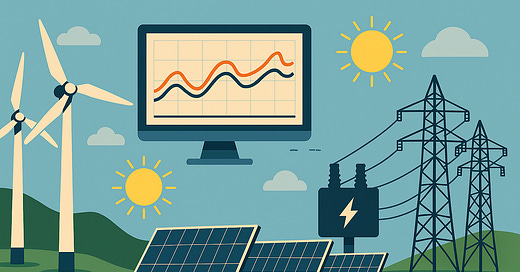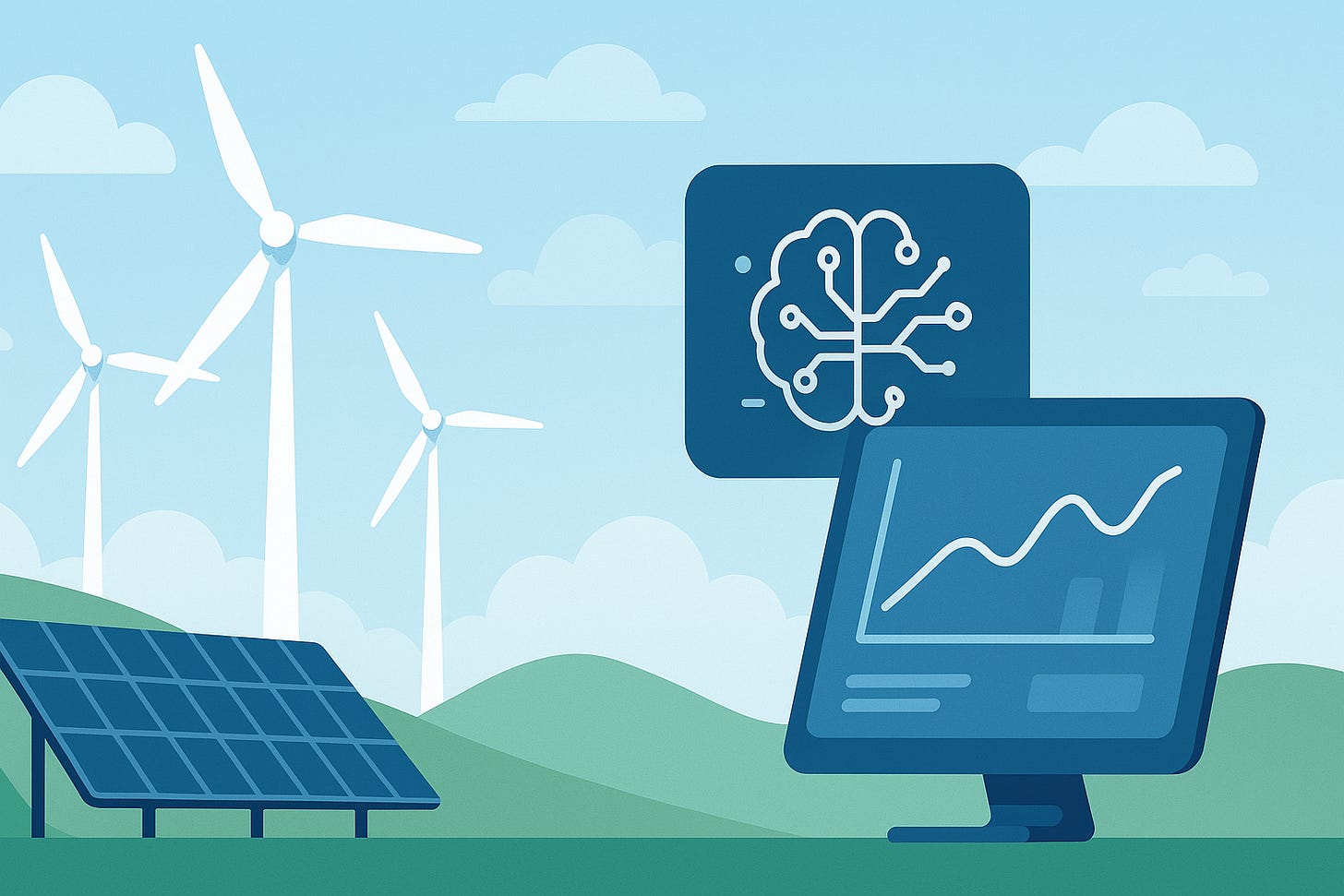Windletter by Rawenwits - Renewable generation forecasting using artificial intelligence
Discover Ravenwits, the Spanish company revolutionizing wind and solar energy forecasting with artificial intelligence
Hello everyone and welcome to a new issue of Windletter. I'm Sergio Fernández Munguía (@Sergio_FerMun) and here we discuss the latest news in the wind power sector from a different perspective. If you're not subscribed to the newsletter, you can do so here.
Let’s go today with a special edition sponsored by Ravenwits, a startup based in Madrid whose mission is to deliver precise and reliable forecasts for renewable energy production plants.
Ravenwits was born as a university spin-off following five years of collaboration between the Complutense and Polytechnic Universities of Madrid, and the Spanish electricity system operator, Red Eléctrica de España.
Its founders, PhDs specialized in mathematical analysis and deep learning, have successfully transformed their academic research into a commercial innovation: a SaaS (Software as a Service) platform capable of predicting wind and solar power generation with remarkable accuracy.
We are truly pleased to have Ravenwits on board, a clear example of entrepreneurship born from academic research, powered by technology capable of competing with the world’s leading players in the market.
Stick with me and I’ll tell you all the details 👇
🧠 The art of forecasting renewable generation with AI techniques
In a world where the energy transition is advancing rapidly, integrating renewable energy into the power system presents a crucial challenge: accurately forecasting wind and solar generation.
The variability of wind and solar radiation makes the reliability of these forecasts essential for maintaining grid balance, optimizing energy sales, and minimizing deviation costs incurred by asset owners and end consumers.
🌱 The beginnings of Ravenwits
Until recently, renewable generation forecasting relied on traditional statistical methods, combined with meteorological adjustments to improve accuracy. While some companies still follow this approach, the year 2012 marked the beginning of the Deep Learning era, revolutionizing data science and predictive modeling.
Ravenwits was born in this context of technological transformation. Its founding team is made up of professors and academic researchers, experts in mathematics and data science with a solid research background.
Its origins date back to an R&D program on renewable generation forecasting launched in collaboration with the Complutense University of Madrid and Red Eléctrica de España (REE). Within this framework, the founders worked on the development of advanced artificial intelligence models to improve wind power generation forecasts.
What began as a research project soon showed enormous commercial potential, and thus Ravenwits was born — with the mission of bringing these innovations from the lab to the market, offering renewable plant operators a precise, efficient, and adaptable forecasting tool.
🤖 Forecasting wind and solar generation is no easy task
Forecasting renewable energy generation, both wind and solar, is challenging. Traditional models present average errors ranging from 15% to 45% in 24-hour forecasts, which can translate into annual losses of hundreds of thousands of euros for a 50 MW wind farm.
This margin of error not only affects operator profitability, but also represents an obstacle to the large-scale integration of renewables into the power system, as well as a cost to consumers. The more accurate the forecast, the greater the grid stability and the more efficient the operation of the electricity market.
In a sector constantly searching for better predictive tools, Ravenwits positions itself as a new and relevant player, applying artificial intelligence and deep learning to offer more precise models.
💻 Technology: the foundations behind the forecast
Thanks to the use of convolutional neural networks, deep learning, and AI, Ravenwits has developed a technology capable of reducing uncertainty in renewable energy production.
Below is a flowchart of the forecasting system used by Ravenwits, which we explain in simple terms further down.
Ravenwits’ forecasting models are based on the analysis of past patterns to anticipate the future behavior of renewable generation. To do this, they train their artificial intelligence using historical data (known in the industry as a training dataset) from two key sources:
Historical data from specialized meteorological agencies (weather data).
Historical real generation data from their clients' plants (energy data).
Both the training and the programming of these models (model training) are the technological core of Ravenwits and what allows it to stand out in the market. From past scenarios, their models learn to identify trends and behaviors.
Once trained (trained models), the models need real-time information to make future forecasts (model inference). For this purpose, they incorporate updated weather forecasts from specialized agencies.
Every hour, Ravenwits provides its clients with forecasts for each of the next 240 hours, from H+1 to H+240. Interestingly, forecasts are now generated for each fifteen-minute interval, as the system recently transitioned to 15-minute granularity.
The generated predictions are the final product Ravenwits delivers to its clients (forecast delivery), providing detailed estimates with a granularity that reaches the level of each individual plant.
In addition, the model is continuously refined, as it compares its forecasts with actual results to improve accuracy with each new iteration. This is especially relevant for newer plants where there is not yet a large amount of historical data available.
⚡ Validated and competitive commercial product
Despite being a young company, Ravenwits has managed to develop a solid and reliable product, with accuracy comparable to—or even exceeding—that of major market players.
Its client portfolio backs this up, including some of the industry's most important plant operators such as Nexus, Fortia, L’ENERGÉTICA, and EDP. Additionally, it also works with Red Eléctrica de España (REE), with whom they have been collaborating for 5 years following that initial pilot program.
Operators usually conduct comparative tests between different forecasting providers, evaluating their models and running them in real generation plants. After this trial period, results are analyzed, and only the most accurate and reliable solutions are selected.
Ravenwits has successfully passed these competitive processes, being chosen as a service provider by international clients. This not only validates its technology but also demonstrates its ability to compete with and outperform the industry's leading names under real-world operating conditions.
💼 Business model and client benefits
Ravenwits' core value proposition is reducing the imbalance cost in renewable electricity sales. In power markets, operators must commit in advance to the amount of energy they will deliver the next day (D+1), but due to wind and solar variability, prediction accuracy is limited.
Any discrepancy between committed and actual energy incurs penalties. If a wind or solar farm generates more or less than forecasted, it faces imbalance costs that can significantly impact its profitability.
For example, in a market where electricity is sold at €100/MWh, the imbalance cost might be around €20/MWh. This means that forecast errors have a direct financial impact on operators’ margins. And in markets with increasing renewable penetration, imbalance costs are rising significantly.
This is where Ravenwits makes a difference. If its technology improves forecasts by just 5% over the competition, the operator can save a significant amount per year for every installed MW.
It's a classic win-win: if the client saves money with better predictions, the service pays for itself—there’s no reason not to hire it.
Moreover, it doesn’t make sense not to hire the best forecasting services in the market, as they generate the highest savings. This results in a near “winner takes all” market dynamic, where only a handful of companies capable of delivering the most accurate forecasts will capture the entire global market share (excluding China, for now).
Most wind and solar asset operators use at least two forecasting service providers, ensuring they can operate their plants with the confidence of having predictions from two different sources.
📬 Want to know more about Ravenwits?
If you're interested in learning more about Ravenwits and its services—or want to start a pilot trial—you can get in touch via:
The contact form on their website (scroll to the bottom of the page)
Email: info@ravenwits.com
Feel free to tell them you came from Windletter 🙂.
And if it’s not for you, but you know someone who might be interested, forward this email. Both Windletter and Ravenwits will be very grateful 🙂.
Thank you very much for reading Windletter. If you enjoyed it, I invite you to subscribe, hit the ❤️, forward it by email, share it on social media, or recommend it to others.
You can follow Windletter on Twitter and LinkedIn, and you can contact me through my Twitter or LinkedIn profile.
See you next time!









